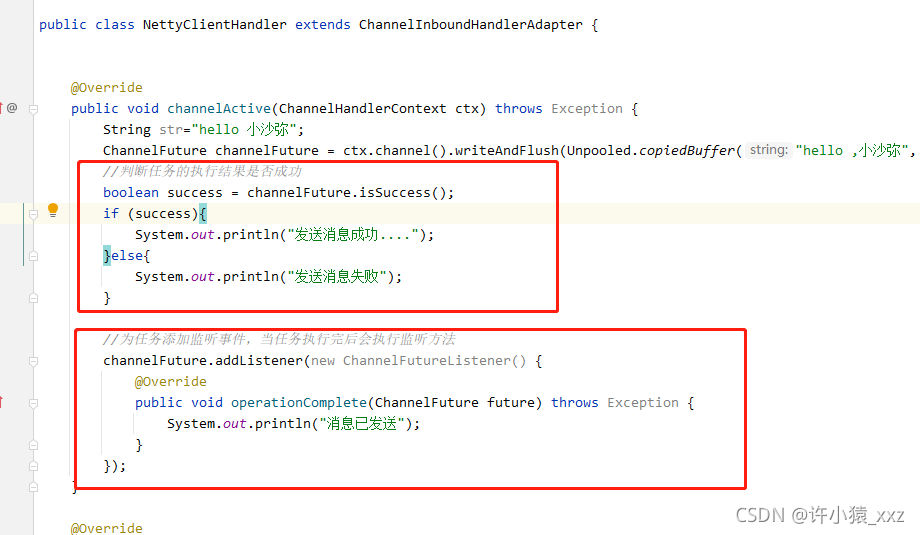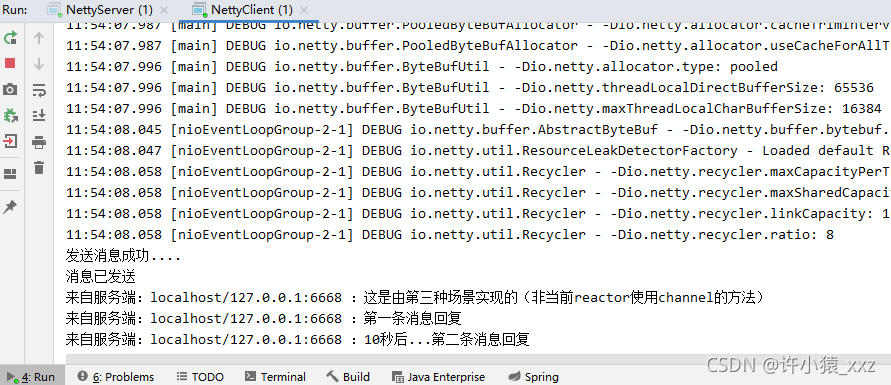一、异步模型
1.1、基本介绍
- 异步的概念和同步相对,当一个异步过程调用发出后,调用者不能立刻得到。实际处理这个调用的组件在完成后,通过状态、通知和回调来通知调用者。
- Netty中的IO操作是异步的,包括Bind,Write、Connect等操作会简单的返回一个ChannelFuture。
- 调用者并不能立刻获得结果,而是通过Future-Listener机制,用户可以方便的主动获得或者通过通知机制获得IO操作结果
- Netty的异步模型是建立在future和callback的之上的。callback就是回调。重点说Future,他的核心思想是:假设一个方法fun,计算过程可能非常耗时,等待fun返回显然不合适,那么可以在调用fun的时候,立马返回一个future,后续可以通过future去监控方法fun的处理过程(即:future-listener机制)
1.2 Future说明
- 表示异步的执行结果,可以通过它提供的方法来检测执行是否完成,比如检索计算等等。
- ChannelFuture是一个接口:我们可以添加监听器,当监听的时间发生时,就会通知监听器。
1.3 异步模型
在使用Netty进行编程时,看接操作和转换出入站数据只需要您提供callback或利用future即可。这使得链式操作简单、高效、并有利于编写高可重用的、通用的代码。
Netty框架的目标就是让你的业务逻辑从网络基础应用中分离出来、解脱出来

在每一个handler中的方法里,都可以添加异步操作
1.4 future-Listener机制
当Future对象刚刚创建时,处于非完成状态,调用者可以通过返回的ChannelFuture来获取操作执行的状态,注册监听函数来执行完成后的操作
常见有如下操作💥
通过isDone方法来判断当前操作是否完成
通过isSuccess方法来判断已完成的当前操作是否成功
通过getCause方法来获取已完成的当前操作失败的原因
通过isCancelled方法来判断已完成的当前操作是否被取消
通过addListener方法来注册监听器,当操作已完成(isDone 方法返回完成),将会通知指定的监听器,如果Future对象已完成,则通知指定的监听器
二、 代码实例演示
实验目的:
- 研究Netty的异步模型的工作机制
- 学习如果监听任务的执行状态
- 掌握ChannelFuture、future-Listener
实验步骤
- 服务端启动服务
- 客户端连接客户端,并向客户端发送一条消息
- 服务端接收客户端消息后向客户端回复一条消息
- 向客户端的发消息任务添加一个 监听事件 和 判断发送结果的方法
2.1 NettyServer代码
package com.netty.taskQueue; import io.netty.bootstrap.ServerBootstrap; import io.netty.buffer.Unpooled; import io.netty.channel.ChannelFuture; import io.netty.channel.ChannelInitializer; import io.netty.channel.ChannelOption; import io.netty.channel.nio.NioEventLoopGroup; import io.netty.channel.socket.SocketChannel; import io.netty.channel.socket.nio.NioServerSocketChannel; import io.netty.util.CharsetUtil; import io.netty.util.concurrent.Future; import io.netty.util.concurrent.GenericFutureListener; import java.net.ServerSocket; public class NettyServer { public static void main(String[] args) throws InterruptedException { //创建线程池对象 NioEventLoopGroup bossGroup = new NioEventLoopGroup(); NioEventLoopGroup workGroup = new NioEventLoopGroup(); //创建配置启动类 ServerBootstrap serverBootstrap = new ServerBootstrap(); try { //添加相关配置 serverBootstrap.group(bossGroup, workGroup)//添加线程池组 .channel(NioServerSocketChannel.class)// .option(ChannelOption.SO_BACKLOG, 128)// .childOption(ChannelOption.SO_KEEPALIVE, true)// .childHandler(new ChannelInitializer<SocketChannel>() { @Override protected void initChannel(SocketChannel ch) throws Exception { //可以使用一个集合管理SocketChannel,再推送消息时,可以将业务加入到各个channel //对应的NIOEventLoop的 ch.eventLoop().execute(new Runnable() { @Override public void run() { ch.writeAndFlush(Unpooled.copiedBuffer("这是由第三种场景实现的(非当前reactor使用channel的方法)", CharsetUtil.UTF_8)); } }); //每个客户端的ch.hashcode都不同,可以作为用户标识 System.out.println("客户端的ch.hashcode="+ch.hashCode()); ch.pipeline().addLast(new NettyServerHandler()); } }); //绑定端口 ChannelFuture cf = serverBootstrap.bind(6668).sync(); //监听通道关闭 cf.channel().closeFuture().sync(); }finally { bossGroup.shutdownGracefully(); workGroup.shutdownGracefully(); } } }2.2 NettyServerHandler代码实现
package com.netty.taskQueue; import io.netty.buffer.ByteBuf; import io.netty.buffer.Unpooled; import io.netty.channel.ChannelHandlerContext; import io.netty.channel.ChannelInboundHandlerAdapter; import io.netty.util.CharsetUtil; import java.util.concurrent.TimeUnit; public class NettyServerHandler extends ChannelInboundHandlerAdapter { //读取客户端的数据 @Override public void channelRead(ChannelHandlerContext ctx, Object msg) throws Exception { System.out.println("来自客户端:" + ctx.channel().remoteAddress() + " :" + ((ByteBuf) msg).toString(CharsetUtil.UTF_8)); //加入自定义定时任务 //schedule()方法 有三个参数: 1、Runnable对象,2、定时时间(多长时间后执行), 3、时间单位 ctx.channel().eventLoop().schedule(new Runnable() { @Override public void run() { ctx.channel().writeAndFlush(Unpooled.copiedBuffer("10秒后...第二条消息回复",CharsetUtil.UTF_8)); } },10, TimeUnit.SECONDS); } //回复消息给客户端 @Override public void channelReadComplete(ChannelHandlerContext ctx) throws Exception { ctx.writeAndFlush(Unpooled.copiedBuffer("第一条消息回复",CharsetUtil.UTF_8)); } @Override public void exceptionCaught(ChannelHandlerContext ctx, Throwable cause) throws Exception { ctx.channel().close(); cause.printStackTrace(); } }2.3 NettyClient 代码实现
package com.netty.taskQueue; import io.netty.bootstrap.Bootstrap; import io.netty.channel.ChannelFuture; import io.netty.channel.ChannelInitializer; import io.netty.channel.nio.NioEventLoopGroup; import io.netty.channel.socket.SocketChannel; import io.netty.channel.socket.nio.NioSocketChannel; public class NettyClient { public static void main(String[] args) throws InterruptedException { NioEventLoopGroup group = new NioEventLoopGroup(); Bootstrap bootstrap = new Bootstrap(); try { bootstrap.group(group) .channel(NioSocketChannel.class) .handler(new ChannelInitializer<SocketChannel>() { @Override protected void initChannel(SocketChannel ch) throws Exception { ch.pipeline().addLast(new NettyClientHandler()); } }); ChannelFuture cf = bootstrap.connect("localhost", 6668).sync(); cf.channel().closeFuture().sync(); }finally { group.shutdownGracefully(); } } }2.4 NettyClientHandler代码实现
package com.netty.taskQueue; import com.sun.org.apache.bcel.internal.classfile.Unknown; import io.netty.buffer.ByteBuf; import io.netty.buffer.Unpooled; import io.netty.channel.*; import io.netty.util.CharsetUtil; import io.netty.util.concurrent.Future; import io.netty.util.concurrent.GenericFutureListener; public class NettyClientHandler extends ChannelInboundHandlerAdapter { @Override public void channelActive(ChannelHandlerContext ctx) throws Exception { String str="hello 小沙弥"; ChannelFuture channelFuture = ctx.channel().writeAndFlush(Unpooled.copiedBuffer("hello ,小沙弥", CharsetUtil.UTF_8)); //判断任务的执行结果是否成功 boolean success = channelFuture.isSuccess(); if (success){ System.out.println("发送消息成功...."); }else{ System.out.println("发送消息失败"); } //为任务添加监听事件,当任务执行完后会执行监听方法 channelFuture.addListener(new ChannelFutureListener() { @Override public void operationComplete(ChannelFuture future) throws Exception { System.out.println("消息已发送"); } }); } @Override public void channelRead (ChannelHandlerContext ctx, Object msg) throws Exception { ByteBuf buf = (ByteBuf) msg; System.out.println("来自服务端:"+ctx.channel().remoteAddress()+" :"+buf.toString(CharsetUtil.UTF_8)); } }2.5 结果 及总结


💥推荐阅读💥





 本文深入探讨了Netty框架中的异步模型,包括基本概念、Future-Listener机制及其应用场景。通过具体代码示例,展示了如何利用ChannelFuture监听任务执行状态。
本文深入探讨了Netty框架中的异步模型,包括基本概念、Future-Listener机制及其应用场景。通过具体代码示例,展示了如何利用ChannelFuture监听任务执行状态。

















 519
519

 被折叠的 条评论
为什么被折叠?
被折叠的 条评论
为什么被折叠?










